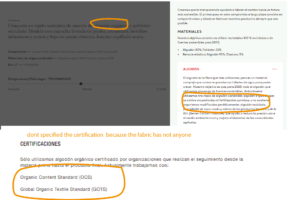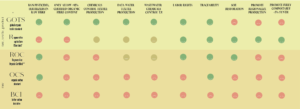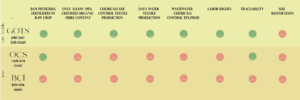LOOK FOR ORGANIC TEXTILE, JUST LOOK FOR GOTS
It is worrying how the confusion about certifications in the textile industry has increased in recent years among citizens. The Agency Consumer of most countries does not regulate against ·#greenwashing which would prevent businesses from making misleading claims. We need the government to establish clear guidelines and effective policies to restrict language that leads to confusion.
In this regard, some countries have taken small actions, such as Norway with the Consumer Authority. This agency claimed that a well known brand breaches Norwegian marketing laws and alleges that the brand used statements as “sustainable materials” to mislead buyers. But this is not enough as there’s no certifying body to decide what “sustainable” brands can market their products as sustainable without having to back it.
In my opinion a solution could be just to allow the use of this kind of terms to companies that have a high level of sustainability scores in a wide field of topics related to minimizing impact to achieve the meaningful changes that Earth needs.
Another example of “subtle“ greenwashing is that we can find the term “organic” in the page product or in labels with no reference of the certifications that it is related to or worst mention GOTS and OCS don’t specify what it is made of the product. This is important because most large corporations use the lax ones as OCS that are only at the crop level, which leads the consumer to believe by default that organic cotton means organic textile and that the fabric is free of toxic chemicals, therefore it does not participate in the pollution of rivers through water waste or that is healthy for allergic skin, which it is obvious that it has a great chance that it is so. It is estimated that about 20% of global water pollution is caused by dyeing and finishing textile products, so at the end it is not so subtle.

That is why I would like to shed a bit of light on textiles certifications in order to make them more comprehensive for conscious consumers. I have created a chart of the ones which we find on the Europe market together with the topics that seem most relevant to SUSTAIN the environment. First of all we should distinguish between the ones that are on farm/raw, textile and product level as Global Organic Textile and Fibershed and the ones that are just at farm level as Organic Content Standard ,Better Cotton Initiative or Regenerative Organic Certified. GOTS, OCS, BCI are the certifications widely accessible to consumers although I have also decided to include Regenerative Agriculture Fibershed* and Regenerative Organic Certified** because I have been lately reading the term ”regenerative” in an indiscriminate way. I leave for another occasion others as “resource-efficient farming”.
REGENERATIVE AS A PLAYING FIELD OF GREENWASHING

I have observed the rise of headlines as “Regenerative Fashion Goes Beyond Organic” and how “regenerative” is replacing the term organic in the reports of sustainability of some fashion corporations and foundations in which it is avoided explicitly to use the term organic farming. Regenerative agriculture assumes that the soil has already been so damaged that we need to build back before we can get by with merely sustaining it. It specifically avoids monocultures (which organic farming uses) which helps in the main problems as erosion soil and allows the restoration to have an efficient sequestration carbon.
Regenerative agriculture has been undefined as it is still not a THIRD party certification and therefore open to greenwashing. There are two organizations that have been setting guidelines in the recent years. I hope we can see proposals in Regenerative organic certification in the European textile industry from non-profit policy directors in the next future and of course apart from large fashion corporations and private companies.
Fibershed is a community-based nonprofit organization called founded by Rebecca Burgess from Northern California which is doing an amazing good job in Regenerative practices going beyond much more than farming level. Fibershed has its own certificate from soil to fiber and has a Community Supported Cloth that helps connect supply chains partners weaving in the US. The problem is that other companies have been starting to use “regenerative” as an open window to still use synthetic fertilizers and pesticides in the next future. It may seem contradictory and of course it is, as Nishantah from Oshadi told me “as using them serves no purpose to the fundamental meaning as using chemicals lead to degenerating the soil and the ecosystem instead”. Regenerative agriculture from Fibershed still uses synthetic chemical fertilizers and pesticides, although they try to reduce that: “Our approach is specifically to place where producers are. So, specific practices do vary, with the goals of reducing inputs like synthetic fertilizers and pesticides.” So still necessary that these kinds of organizations explain in a deep way the policies they have in terms of synthetics inputs.
Regenerative Organic Certified ™ has been created by an outdoor company and other organizations from the US in 2020 precisely to avoid that as it bans synthetic inputs. ROC™ could be the best option in terms of standards in future although is a farm/agriculture level certification. “In order for a ROC™ claim to be made in textile level (not product), all processors in the supply chain must be certified to GOTS or OCS” . As OCS doesn’t have a fabric level certification, we still can not be sure about the toxic chemicals usage and standards of wastewater control in the textile production. I would say a solution for that could be to restrict to standards that are product or textile level and remove OCS from the equation.
I highly recommend the article below that I found looking for greenwashing about the term “regenerative” agriculture to create the chart on certifications on textiles that I have recently published (appreciate feedback). It explains the similarities, differences and synergies between organic, agroecological and regenerative agriculture and the greenwashing involved in the uses of the term Regenerative. https://www.arc2020.eu/comparing-organic-agroecological-and-regenerative-farming-part-3-regenerative/
*Based on the Fibershed website (waiting for direct feedback from the company).
**Regenerative Organic Certified #roc exists from 2020 as a third party certification but it is not widespread yet, still as a phase pilot in US
I would be very grateful to receive feedback about this chart. I have tried to make it easy to understand but without leaving behind important issues but for sure this is a living document that will be updated if new, better certification or more greenwashing arise.


